HND Hospitality Unit 31: Food Safety Management & Prevention
VerifiedAdded on 2023/02/02
|22
|1190
|23
Report
AI Summary
This report provides an overview of food safety management, emphasizing the importance of consumer safety and hygiene in the food industry. It details controls required to prevent physical and chemical contamination, including maintaining cleanliness, proper storage, and safe handling practices. The report differentiates between food poisoning and foodborne infections, outlining their characteristics, causes, and preventive measures. It also addresses specific foodborne illnesses like Cholera, Botulism, and Hepatitis A, discussing sanitation, avoiding canned foods, and practicing personal hygiene to control their spread. The conclusion highlights the significance of food preservation and condemnation in maintaining food quality and ensuring consumer loyalty in the hospitality industry. References to relevant research articles are included to support the information presented.
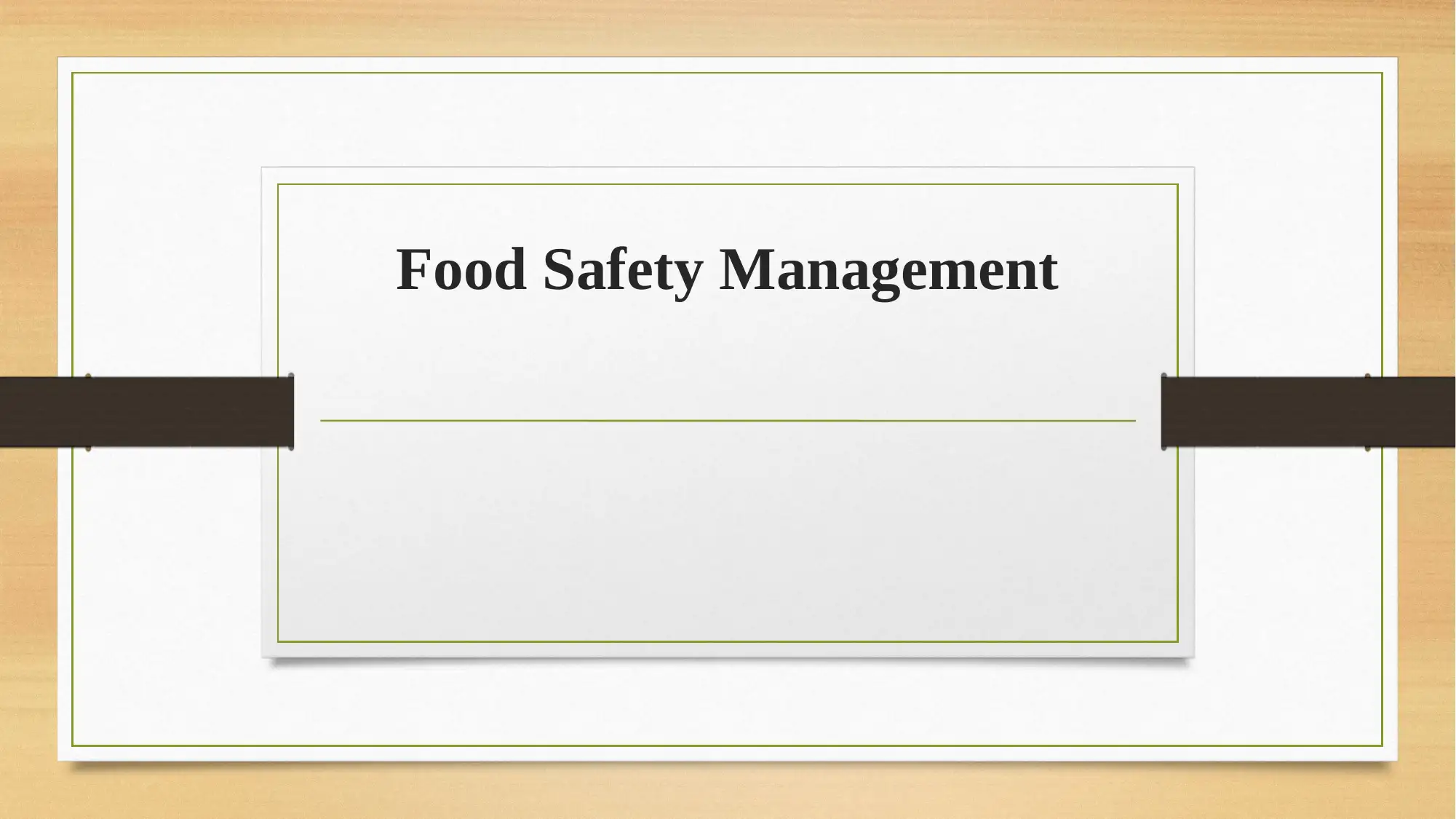
Food Safety Management
Paraphrase This Document
Need a fresh take? Get an instant paraphrase of this document with our AI Paraphraser
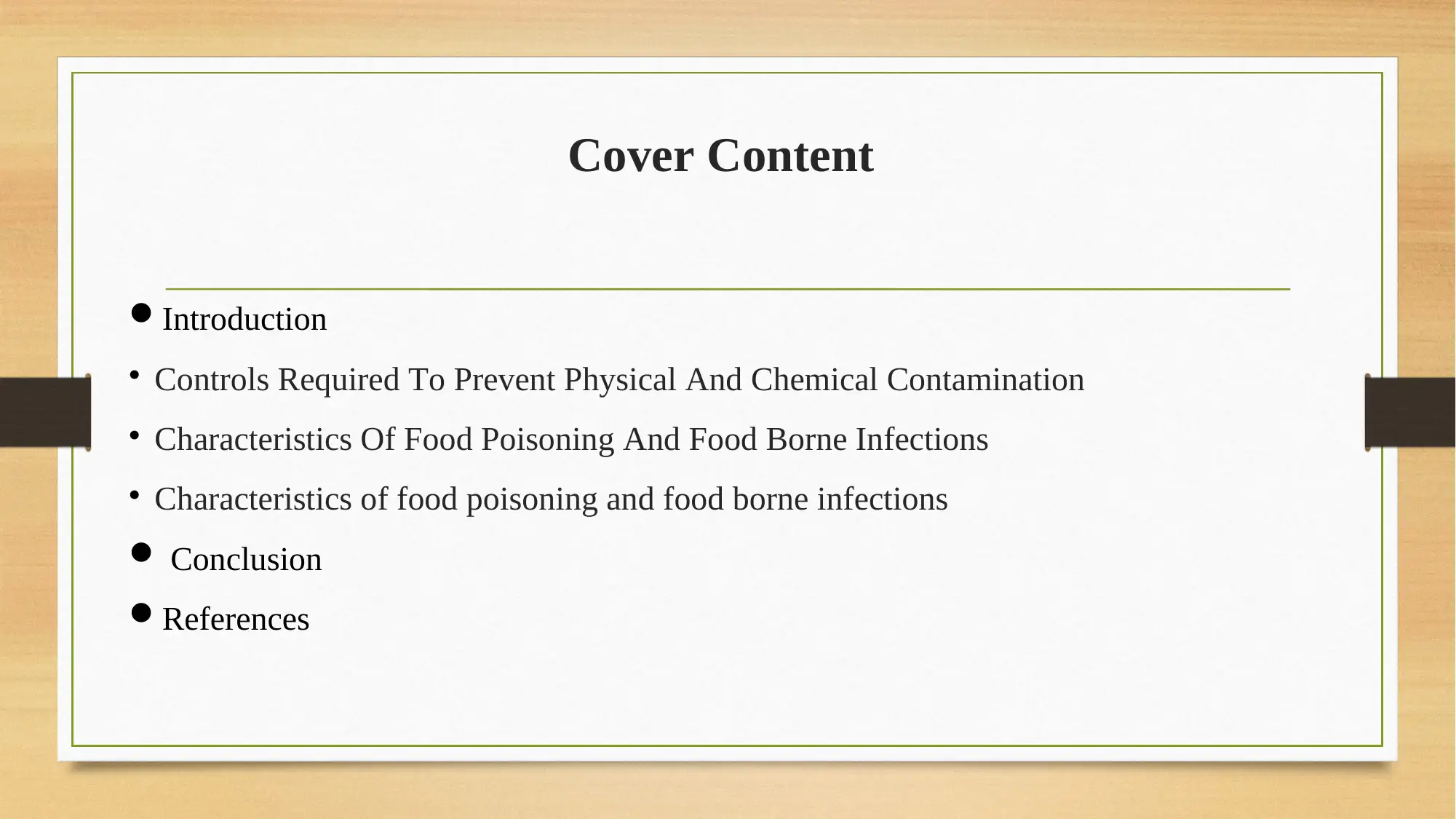
Cover Content
Introduction
Controls Required To Prevent Physical And Chemical Contamination
Characteristics Of Food Poisoning And Food Borne Infections
Characteristics of food poisoning and food borne infections
Conclusion
References
Introduction
Controls Required To Prevent Physical And Chemical Contamination
Characteristics Of Food Poisoning And Food Borne Infections
Characteristics of food poisoning and food borne infections
Conclusion
References
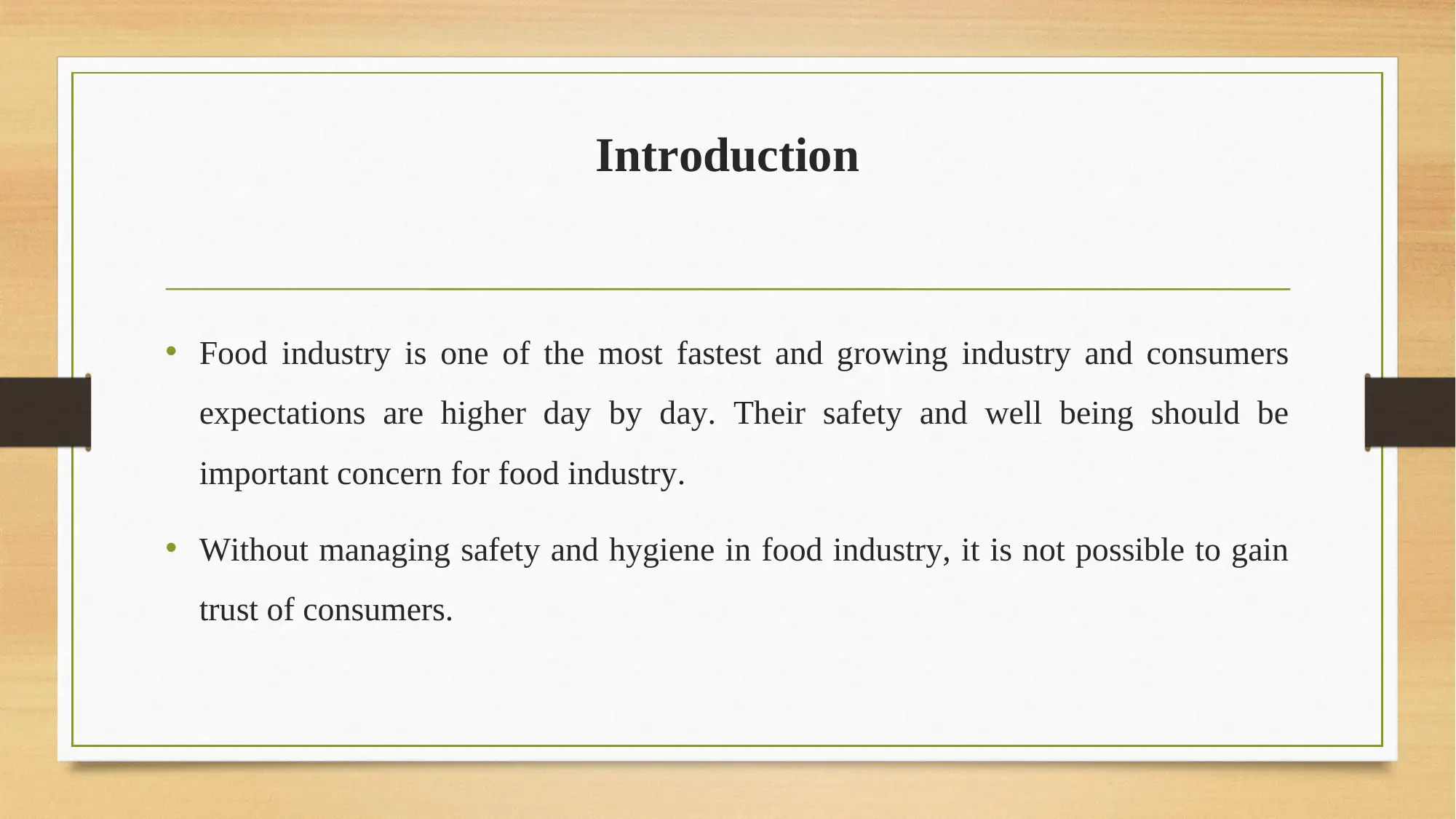
Introduction
• Food industry is one of the most fastest and growing industry and consumers
expectations are higher day by day. Their safety and well being should be
important concern for food industry.
• Without managing safety and hygiene in food industry, it is not possible to gain
trust of consumers.
• Food industry is one of the most fastest and growing industry and consumers
expectations are higher day by day. Their safety and well being should be
important concern for food industry.
• Without managing safety and hygiene in food industry, it is not possible to gain
trust of consumers.
⊘ This is a preview!⊘
Do you want full access?
Subscribe today to unlock all pages.

Trusted by 1+ million students worldwide
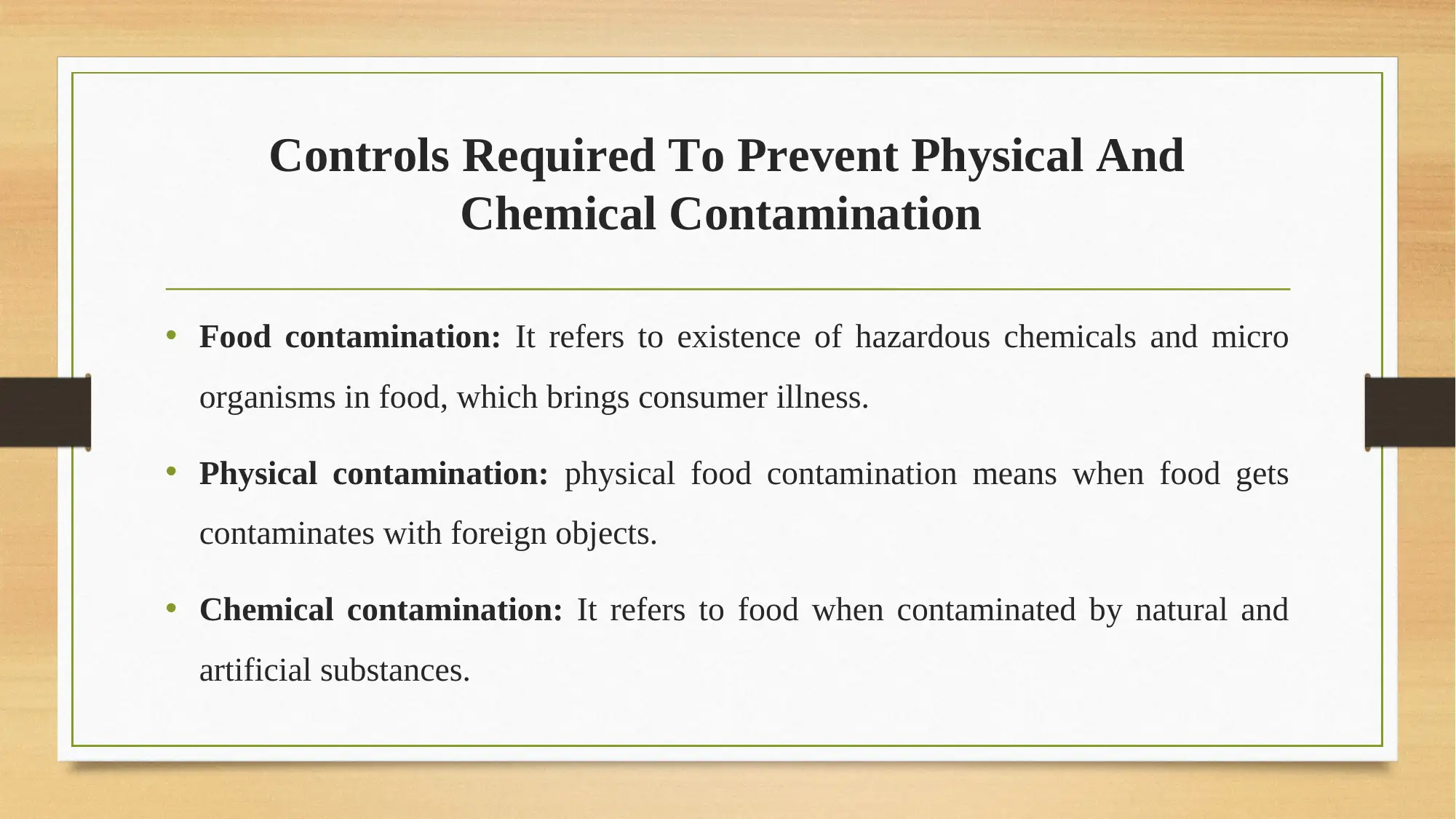
Controls Required To Prevent Physical And
Chemical Contamination
• Food contamination: It refers to existence of hazardous chemicals and micro
organisms in food, which brings consumer illness.
• Physical contamination: physical food contamination means when food gets
contaminates with foreign objects.
• Chemical contamination: It refers to food when contaminated by natural and
artificial substances.
Chemical Contamination
• Food contamination: It refers to existence of hazardous chemicals and micro
organisms in food, which brings consumer illness.
• Physical contamination: physical food contamination means when food gets
contaminates with foreign objects.
• Chemical contamination: It refers to food when contaminated by natural and
artificial substances.
Paraphrase This Document
Need a fresh take? Get an instant paraphrase of this document with our AI Paraphraser
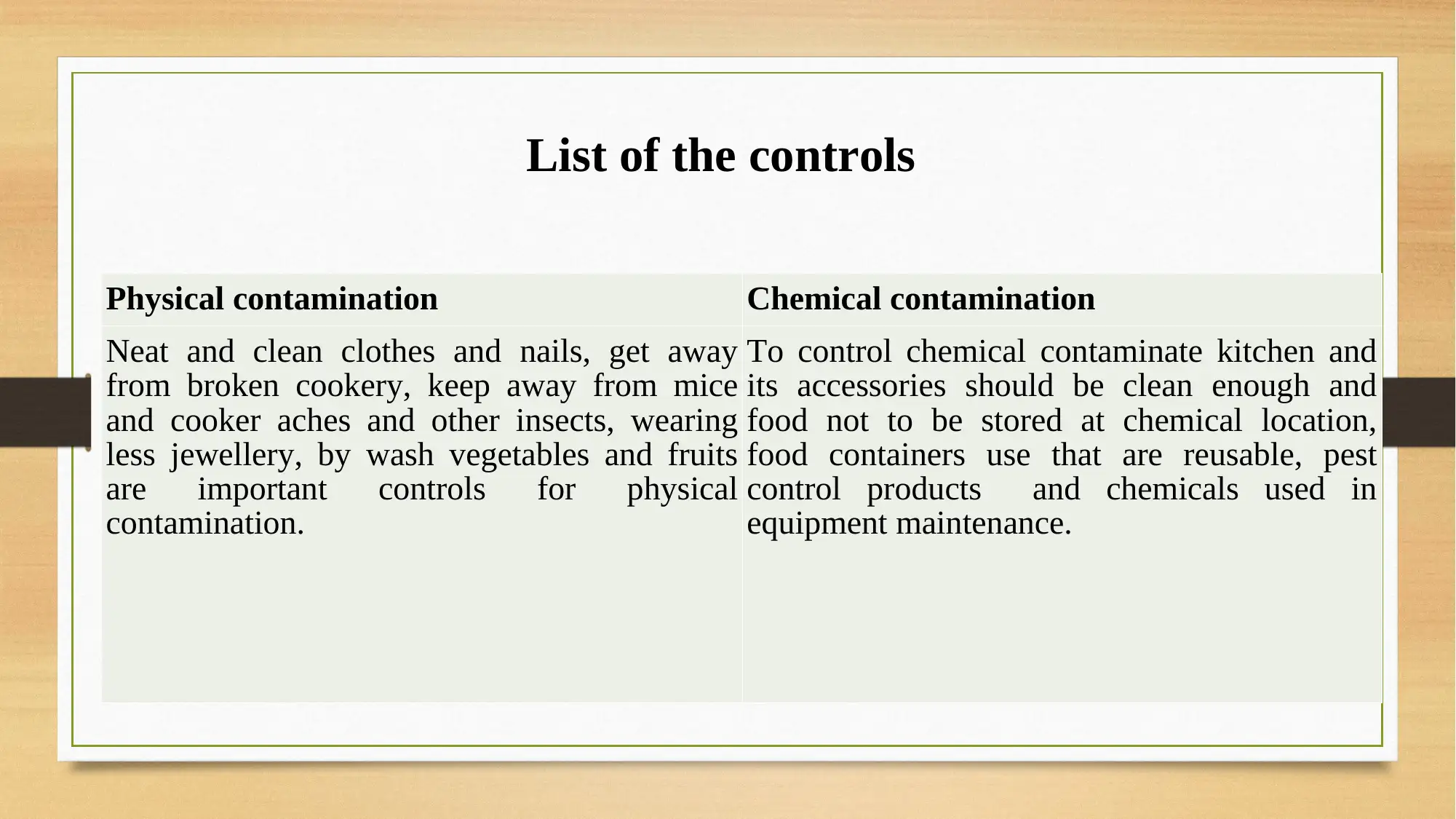
List of the controls
Physical contamination Chemical contamination
Neat and clean clothes and nails, get away
from broken cookery, keep away from mice
and cooker aches and other insects, wearing
less jewellery, by wash vegetables and fruits
are important controls for physical
contamination.
To control chemical contaminate kitchen and
its accessories should be clean enough and
food not to be stored at chemical location,
food containers use that are reusable, pest
control products and chemicals used in
equipment maintenance.
Physical contamination Chemical contamination
Neat and clean clothes and nails, get away
from broken cookery, keep away from mice
and cooker aches and other insects, wearing
less jewellery, by wash vegetables and fruits
are important controls for physical
contamination.
To control chemical contaminate kitchen and
its accessories should be clean enough and
food not to be stored at chemical location,
food containers use that are reusable, pest
control products and chemicals used in
equipment maintenance.
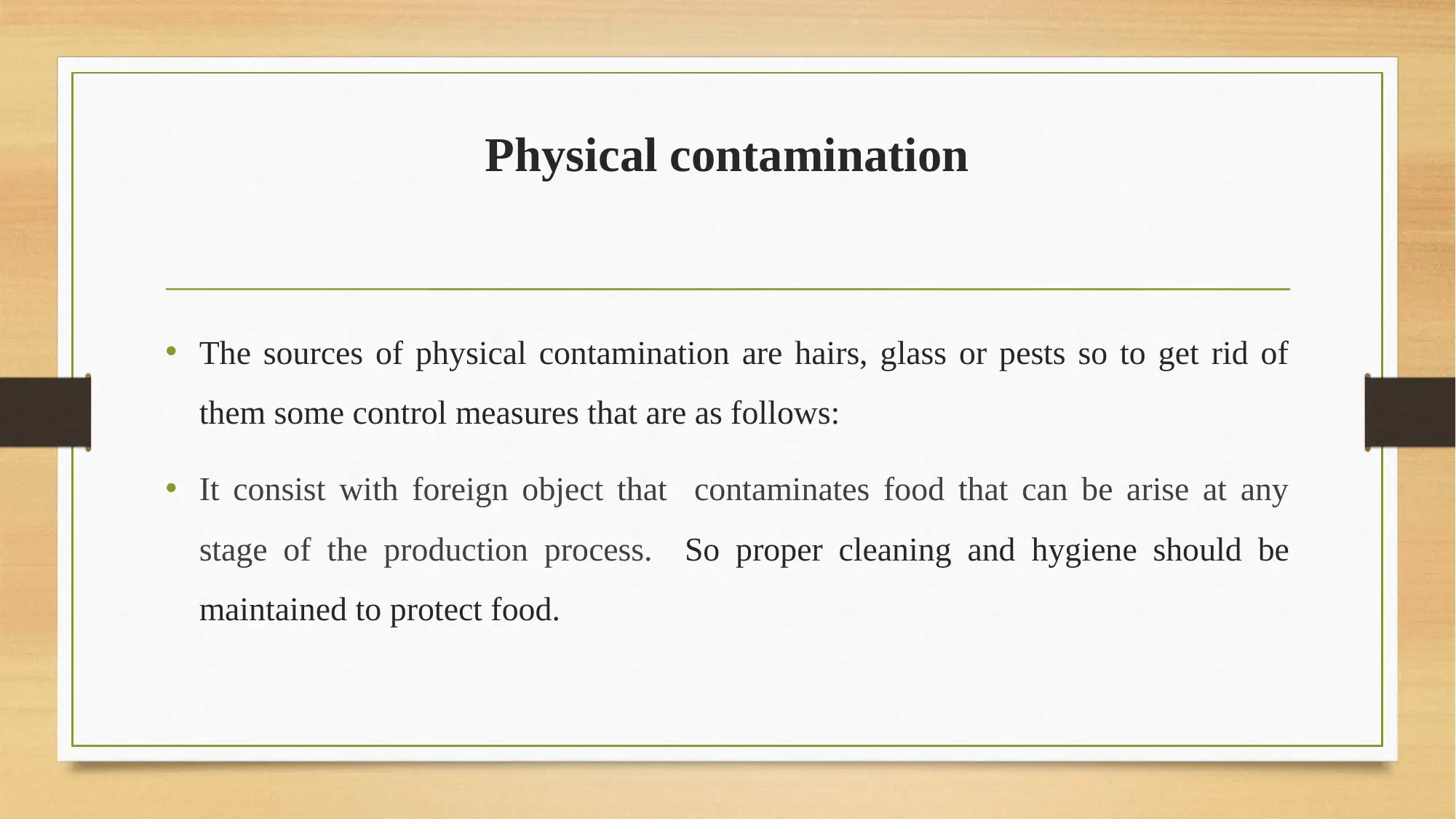
Physical contamination
• The sources of physical contamination are hairs, glass or pests so to get rid of
them some control measures that are as follows:
• It consist with foreign object that contaminates food that can be arise at any
stage of the production process. So proper cleaning and hygiene should be
maintained to protect food.
• The sources of physical contamination are hairs, glass or pests so to get rid of
them some control measures that are as follows:
• It consist with foreign object that contaminates food that can be arise at any
stage of the production process. So proper cleaning and hygiene should be
maintained to protect food.
⊘ This is a preview!⊘
Do you want full access?
Subscribe today to unlock all pages.

Trusted by 1+ million students worldwide
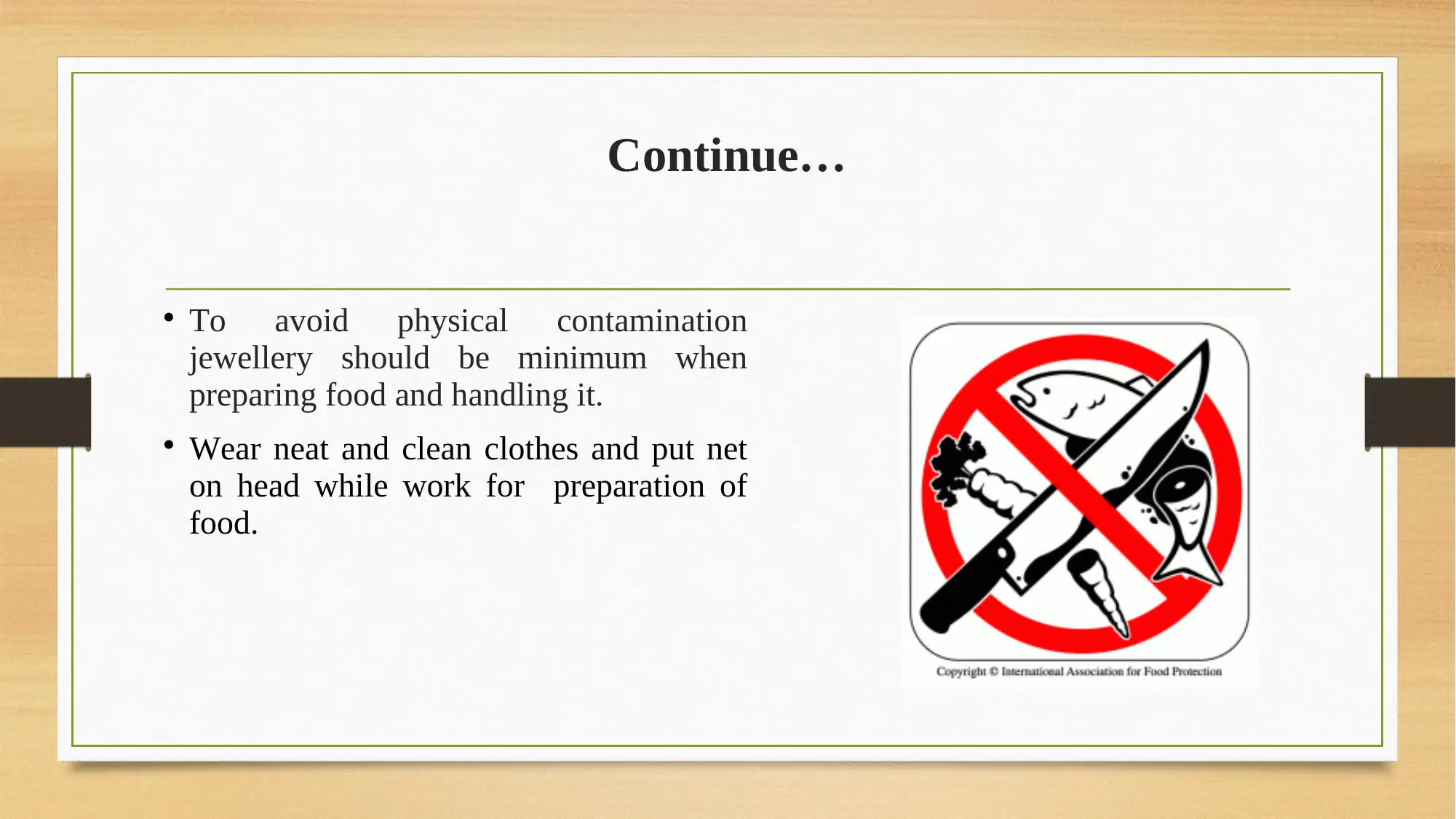
Continue…
To avoid physical contamination
jewellery should be minimum when
preparing food and handling it.
Wear neat and clean clothes and put net
on head while work for preparation of
food.
To avoid physical contamination
jewellery should be minimum when
preparing food and handling it.
Wear neat and clean clothes and put net
on head while work for preparation of
food.
Paraphrase This Document
Need a fresh take? Get an instant paraphrase of this document with our AI Paraphraser
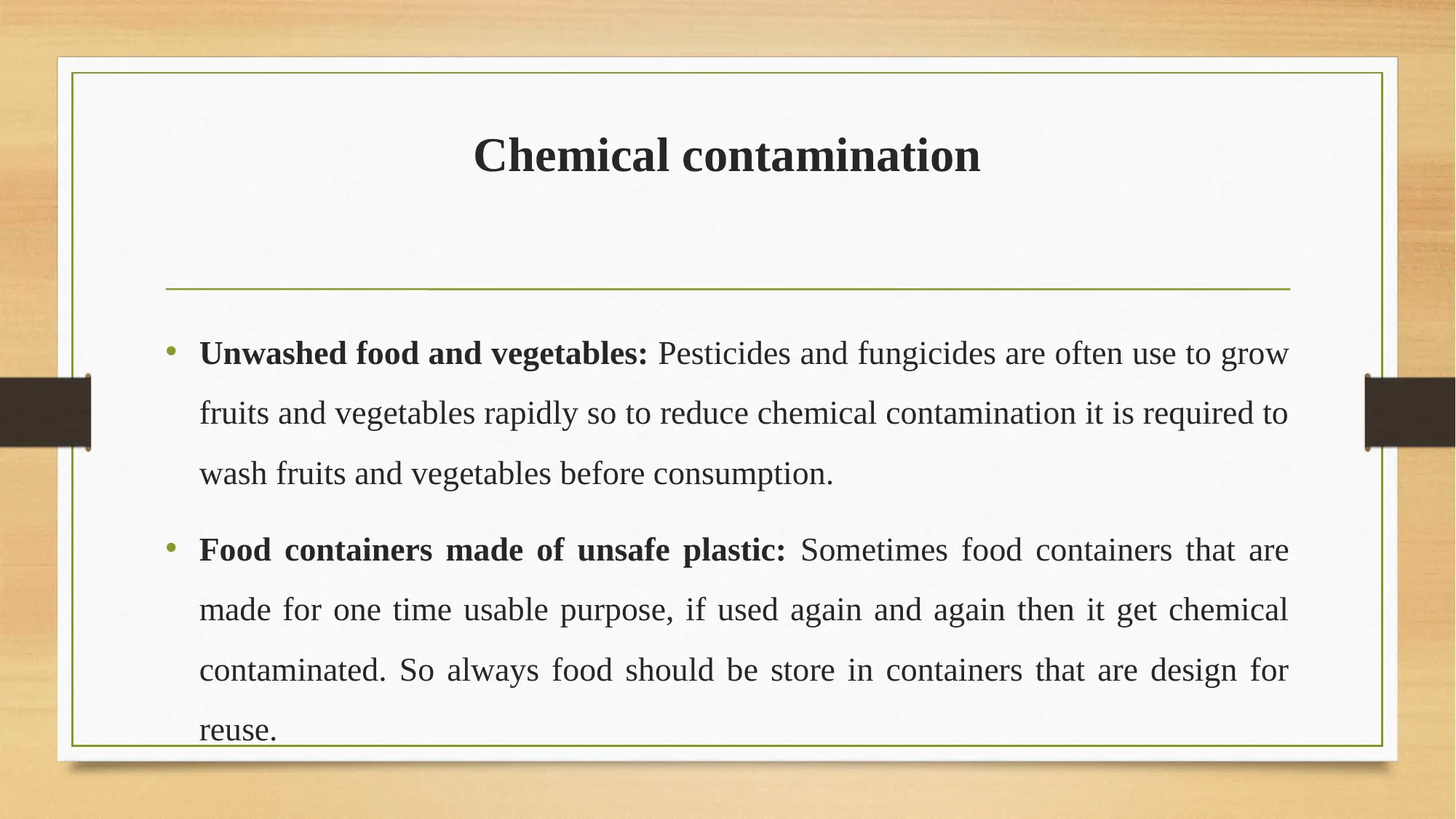
Chemical contamination
• Unwashed food and vegetables: Pesticides and fungicides are often use to grow
fruits and vegetables rapidly so to reduce chemical contamination it is required to
wash fruits and vegetables before consumption.
• Food containers made of unsafe plastic: Sometimes food containers that are
made for one time usable purpose, if used again and again then it get chemical
contaminated. So always food should be store in containers that are design for
reuse.
• Unwashed food and vegetables: Pesticides and fungicides are often use to grow
fruits and vegetables rapidly so to reduce chemical contamination it is required to
wash fruits and vegetables before consumption.
• Food containers made of unsafe plastic: Sometimes food containers that are
made for one time usable purpose, if used again and again then it get chemical
contaminated. So always food should be store in containers that are design for
reuse.
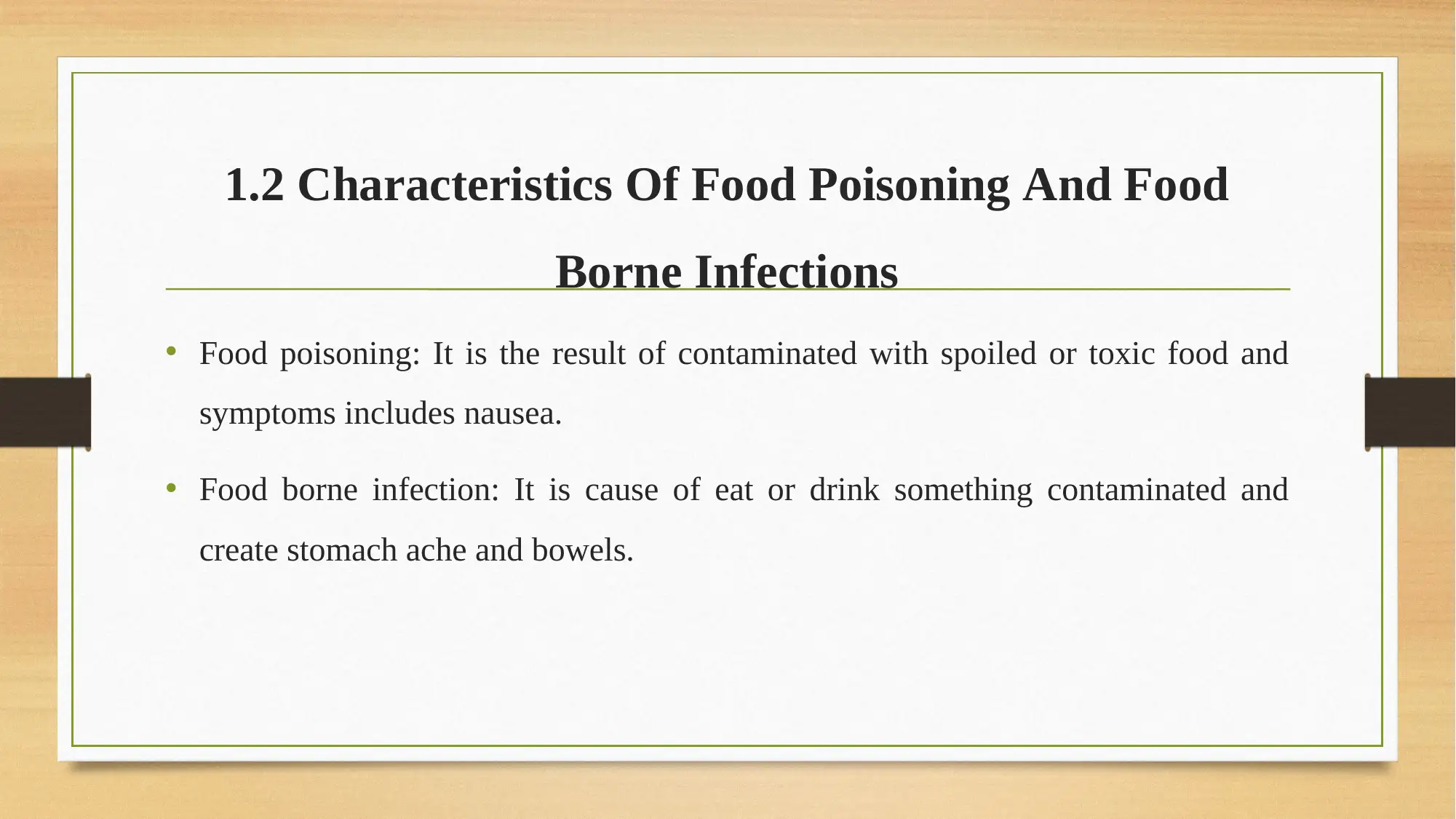
1.2 Characteristics Of Food Poisoning And Food
Borne Infections
• Food poisoning: It is the result of contaminated with spoiled or toxic food and
symptoms includes nausea.
• Food borne infection: It is cause of eat or drink something contaminated and
create stomach ache and bowels.
Borne Infections
• Food poisoning: It is the result of contaminated with spoiled or toxic food and
symptoms includes nausea.
• Food borne infection: It is cause of eat or drink something contaminated and
create stomach ache and bowels.
⊘ This is a preview!⊘
Do you want full access?
Subscribe today to unlock all pages.

Trusted by 1+ million students worldwide
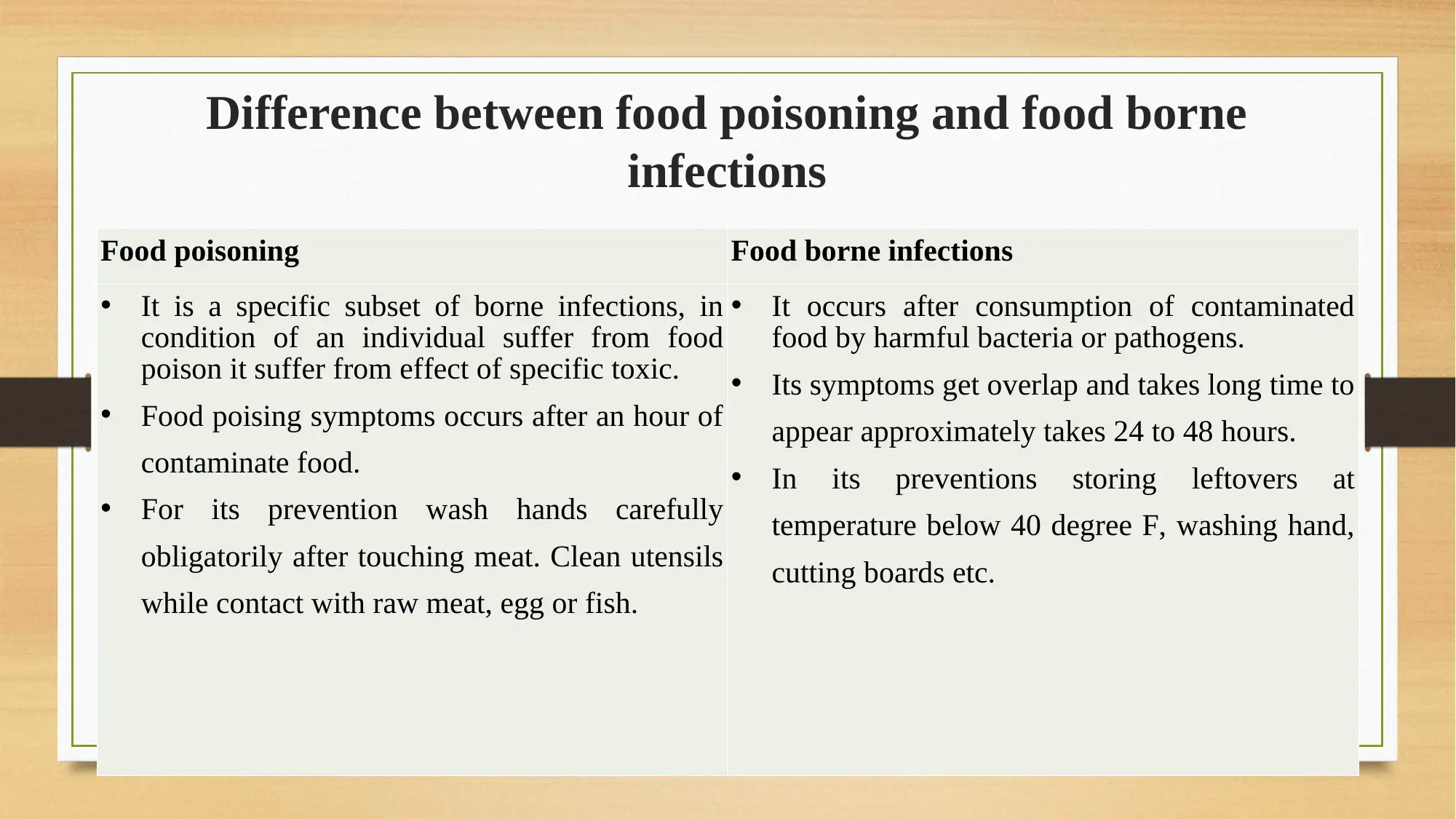
Difference between food poisoning and food borne
infections
Food poisoning Food borne infections
• It is a specific subset of borne infections, in
condition of an individual suffer from food
poison it suffer from effect of specific toxic.
• Food poising symptoms occurs after an hour of
contaminate food.
• For its prevention wash hands carefully
obligatorily after touching meat. Clean utensils
while contact with raw meat, egg or fish.
• It occurs after consumption of contaminated
food by harmful bacteria or pathogens.
• Its symptoms get overlap and takes long time to
appear approximately takes 24 to 48 hours.
• In its preventions storing leftovers at
temperature below 40 degree F, washing hand,
cutting boards etc.
infections
Food poisoning Food borne infections
• It is a specific subset of borne infections, in
condition of an individual suffer from food
poison it suffer from effect of specific toxic.
• Food poising symptoms occurs after an hour of
contaminate food.
• For its prevention wash hands carefully
obligatorily after touching meat. Clean utensils
while contact with raw meat, egg or fish.
• It occurs after consumption of contaminated
food by harmful bacteria or pathogens.
• Its symptoms get overlap and takes long time to
appear approximately takes 24 to 48 hours.
• In its preventions storing leftovers at
temperature below 40 degree F, washing hand,
cutting boards etc.
Paraphrase This Document
Need a fresh take? Get an instant paraphrase of this document with our AI Paraphraser
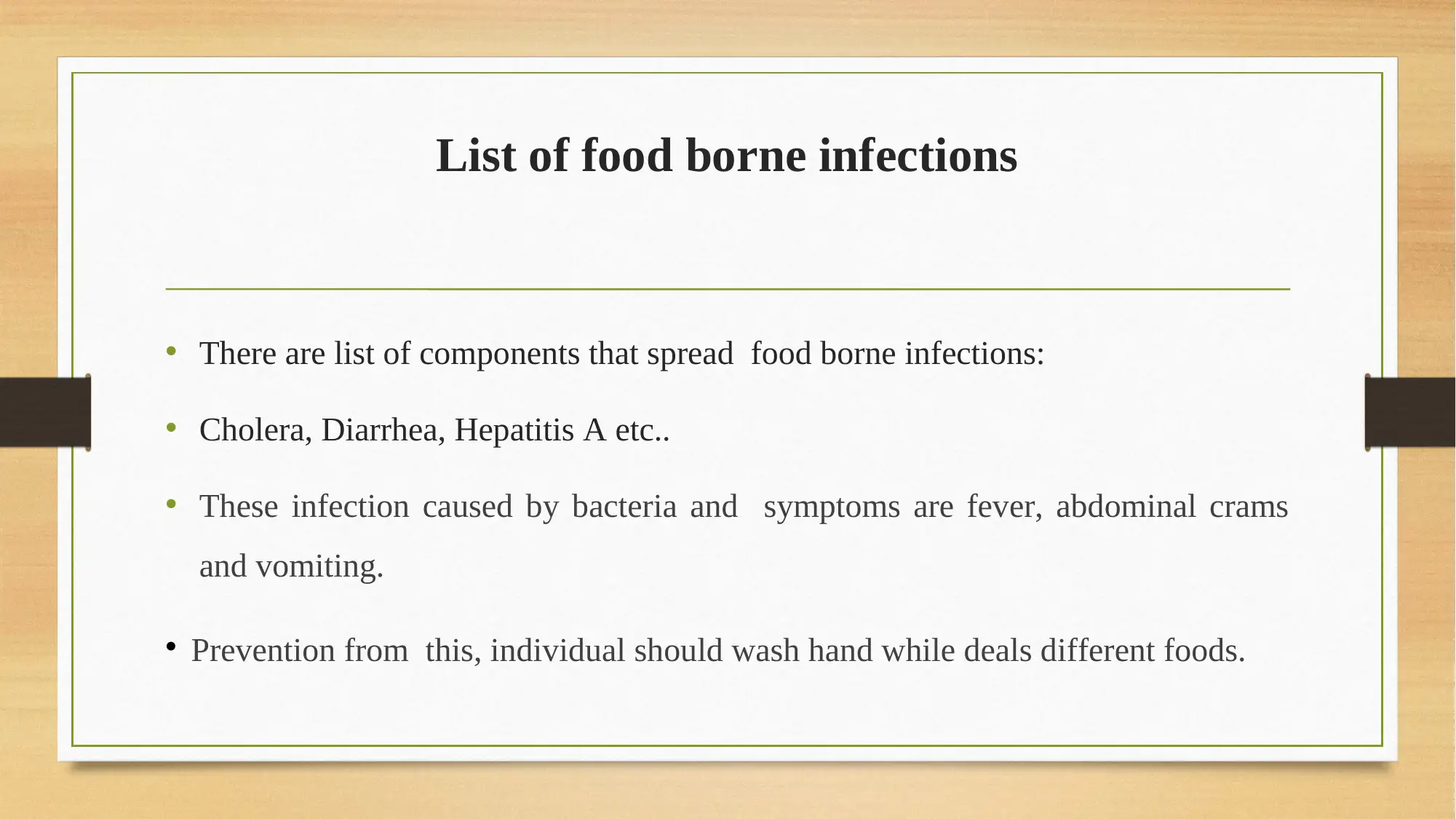
List of food borne infections
• There are list of components that spread food borne infections:
• Cholera, Diarrhea, Hepatitis A etc..
• These infection caused by bacteria and symptoms are fever, abdominal crams
and vomiting.
Prevention from this, individual should wash hand while deals different foods.
• There are list of components that spread food borne infections:
• Cholera, Diarrhea, Hepatitis A etc..
• These infection caused by bacteria and symptoms are fever, abdominal crams
and vomiting.
Prevention from this, individual should wash hand while deals different foods.
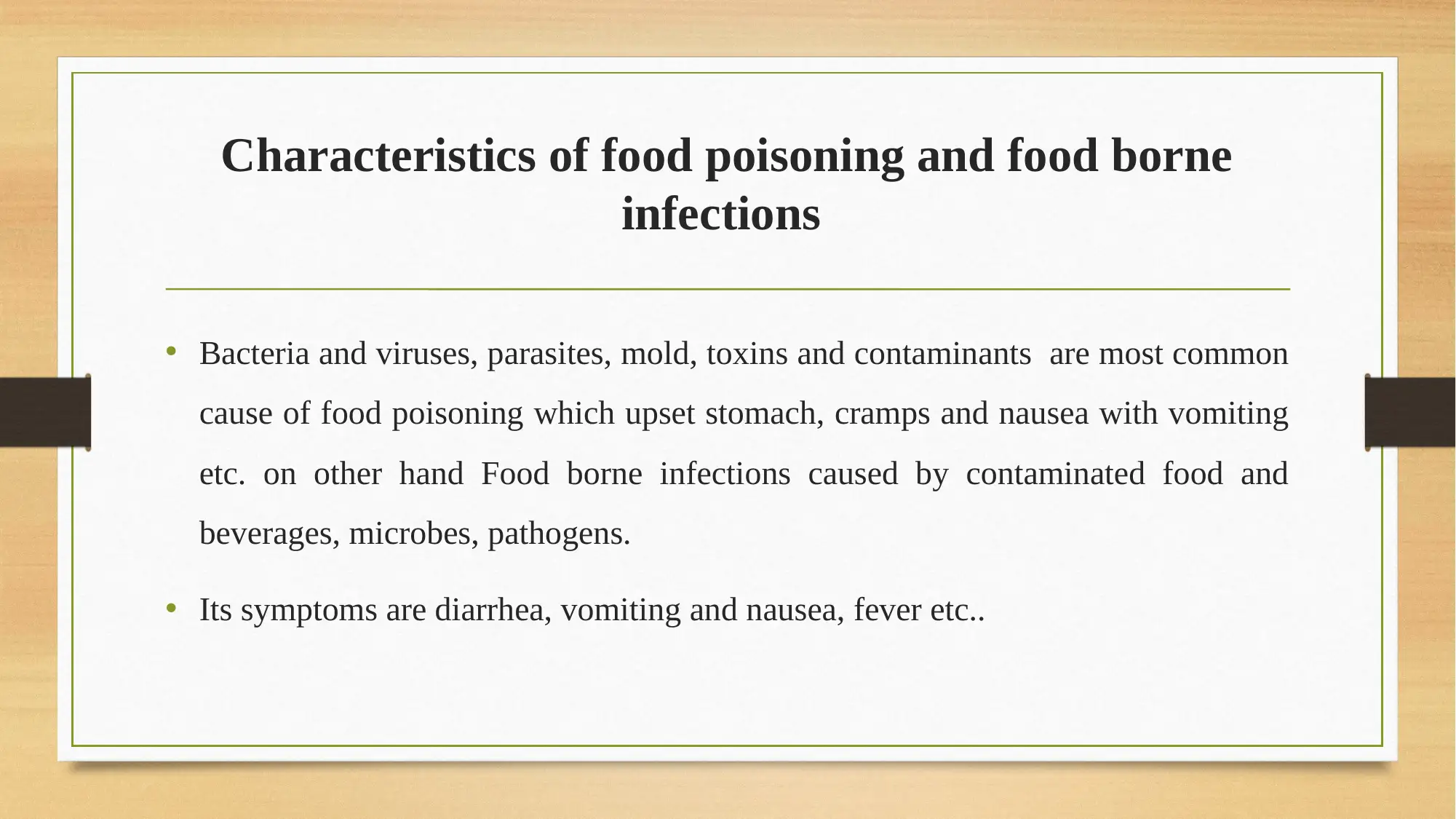
Characteristics of food poisoning and food borne
infections
• Bacteria and viruses, parasites, mold, toxins and contaminants are most common
cause of food poisoning which upset stomach, cramps and nausea with vomiting
etc. on other hand Food borne infections caused by contaminated food and
beverages, microbes, pathogens.
• Its symptoms are diarrhea, vomiting and nausea, fever etc..
infections
• Bacteria and viruses, parasites, mold, toxins and contaminants are most common
cause of food poisoning which upset stomach, cramps and nausea with vomiting
etc. on other hand Food borne infections caused by contaminated food and
beverages, microbes, pathogens.
• Its symptoms are diarrhea, vomiting and nausea, fever etc..
⊘ This is a preview!⊘
Do you want full access?
Subscribe today to unlock all pages.

Trusted by 1+ million students worldwide
1 out of 22
Related Documents
Your All-in-One AI-Powered Toolkit for Academic Success.
+13062052269
info@desklib.com
Available 24*7 on WhatsApp / Email
![[object Object]](/_next/static/media/star-bottom.7253800d.svg)
Unlock your academic potential
Copyright © 2020–2025 A2Z Services. All Rights Reserved. Developed and managed by ZUCOL.





